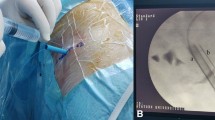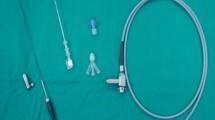Abstract
Objectives
To evaluate the feasibility and safety of performing minimally invasive percutaneous nephrolithotomy (MPCNL) under peritubal local infiltration anesthesia.
Patients and methods
From December 2007 to December 2009, 88 patients with upper urinary calculi underwent MPCNL with ultrasonography (US)-guided renal access in the lateral decubitus flank position under peritubal local infiltration anesthesia. All patients were informed about the possibility of experiencing short periods of discomfort or pain and completed visual analog pain scale (VAS) questionnaires during the intra-operation and at 4, 24, and 48 h postoperatively. Postoperative narcotic usage was recorded at 24 and 48 h postoperatively.
Results
Eighty-two patients (93.2%, 82/88) underwent MPCNL under local anesthetic infiltration, 6 patients were converted to general anesthesia (2.2%, 2/88) or epidural anesthesia (4.4%, 4/88) because of serious pain or discomfort. The average VAS scores intra-operation and at 4, 24, and 48 h postoperatively were 3.1, 3.0, 2.4, and 2.1, respectively. Six patients (7.3%, 6/82) and 2 patients (2.4%, 2/82) were administered pethidine (75 mg) at 24 and 48 h postoperatively, respectively. The stone clearance rate was 88.3% (91/103) before discharge with MPCNL mono-therapy. The mean operative time was 89 min (range 56–145 min).
Conclusion
MPCNL under peritubal local infiltration anesthesia is well-tolerated and feasible alternative to the same procedure under general or epidural anesthesia.

Similar content being viewed by others
References
Fernstrom I, Johansson B (1976) Percutaneous pyelolithotomy: a new extraction technique. Scand J Urol Nephrol 10:257–259
Galvin DJ, Pearle MS (2006) The contemporary management of renal and ureteric calculi. BJU Int 98:1283–1288
Li X, He Z, Wu K et al (2009) Chinese minimally invasive percutaneous nephrolithotomy: the Guangzhou experience. J Endourol 23(10):1693–1697
He Z, Li X, Chen L, Zeng G, Yuan J (2007) Minimally invasive percutaneous nephrolithotomy for upper urinary tract calculi in transplanted kidneys. BJU Int 99:1467–1471
Wu K, Li X, Yuan J et al (1993) Mini nephrostomy with ureteroscopic lithotripsy for staghorn stones. Acad J Guangzhou Med Coll 2:13–14
Jonnavithula N, Pisapati MV, Durga P et al (2009) Efficacy of peritubal local anesthetic infiltration in alleviating postoperative pain in percutaneous nephrolithotomy. J Endourol 23(5):857–860
Dalela D, Goel A, Singh P et al (2004) Renal capsular block: a novel method for performing percutaneous nephrolithotomy under local anesthesia. J Endourol 18(6):544–546
Osman M, Wendt Nordahl G, Heger K et al (2005) Percutaneous nephrolithotomy with ultrasonography-guided renal access: experience from over 300 cases. BJU Int 96(6):875–878
Haleblian GE, Sur RL, Albala DM et al (2007) Subcutaneous bupivacaine infiltration and postoperative pain perception after percutaneous nephrolithotomy. J Urol 178(3):925–928
Karami H, Arbab AH, Rezaei A (2009) Percutaneous nephrolithotomy with ultrasonography-guided renal access in the lateral decubitus flank position. J Endourol 23(1):33–35
Wickham JEA, Miller RA (1983) Applied anatomy. In: Percutaneous renal surgery. Churchill Livingstone, Edinburgh, pp 1–16
El-Husseiny T, Moraitis K, Maan Z et al (2009) Percutaneous endourologic procedures in high-risk patients in the lateral decubitus position under regional anesthesia. J Endourol 23(10):1603–1605
Aravantinos E, Karatzas A, Gravas S et al (2007) Feasibility of percutaneous nephrolithotomy under assisted local anaesthesia: a prospective study on selected patients with upper urinary tract obstruction. Eur Urol 51(1):224–228
Preminger GM, Clayman RV, Curry T et al (1986) Outpatient percutaneous nephrostolithotomy. J Urol 136:355–357
Conflict of interest
The authors declare that they have no conflict of interest.
Author information
Authors and Affiliations
Corresponding author
Additional information
Yong Chen and Zhansong Zhou contributed equally to this article.
Rights and permissions
About this article
Cite this article
Chen, Y., Zhou, Z., Sun, W. et al. Minimally invasive percutaneous nephrolithotomy under peritubal local infiltration anesthesia. World J Urol 29, 773–777 (2011). https://doi.org/10.1007/s00345-011-0730-z
Received:
Accepted:
Published:
Issue Date:
DOI: https://doi.org/10.1007/s00345-011-0730-z




